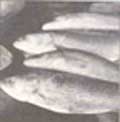Fishing in barraged waters
Fishing in barraged waters

Fisherfolk in the Hooghly are enjoying boom time, with the Farakka Barrage having barred highly valued Hilsa from moving upstream, where procurement has fallen drastically. The average annual catch at Allahabad, which stood at 19.9 tonnes between 1958 and 1972, barely touches 1 tonne now. Over the same time-span, the average haul at Buxar has dropped from 38.6 tonnes to just a few tonnes today.
The worst fears of the Central Inland Capture Fisheries Research Institute (CICFRI), as well as fisherfolk operating in upstream Ganges have come true. The CICFRI study, conducted by D K Dey, has confirmed the almost total disappearance of Hilsa from the Ganges north of the barrage.
Hilsa mostly live in the continental shelf, migrating up the river estuary and brackish water for breeding. The Farakka barrage has hindered this migration, and Hilsas find a passage up the Ganges only when Farakka lock gates are opened during flood-time.
Indiscriminate fishing downstream is also causing much concern. The annual haul in the Hooghly estuary has shot up by 10 times, from 678 tonnes in 1960-61 to 6573 tonnes in 1989-90. Using 2 lakh minute-size drift gill nets, Hooghly fisherfolk are trapping even breeding Hilsas and young hatchlings, causing widespread damage to Hilsa population. It is estimated that 115 tonnes of Hilsa had been destroyed over a 200 km stretch in 1984-85 alone. The CICFRI now wants the micro-nets to be replaced with nets not less than 300 mm in size.







